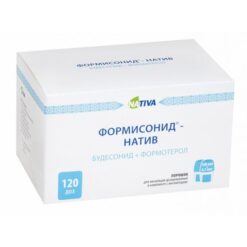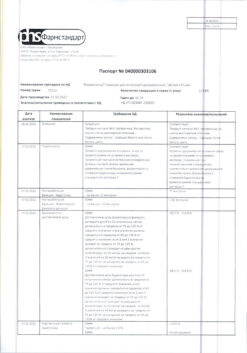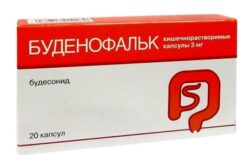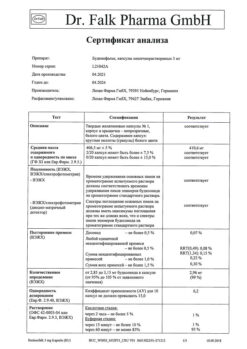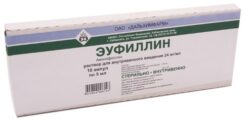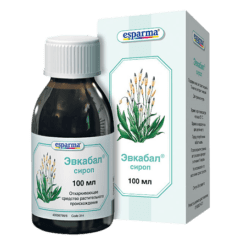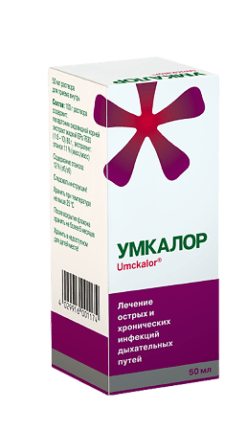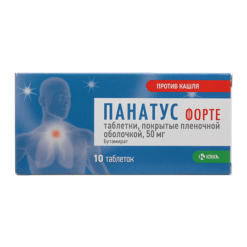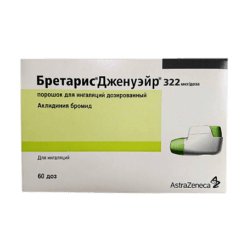No products in the cart.
Seretide Multidisc, 50 mcg+500 mcg/dose 60 doses
€59.85 €49.87
Description
Seretide Multidisc has anti-asthmatic, bronchodilator, anti-inflammatory action.
Pharmacodynamics
The drug Seretide Multidisc is a combined preparation that contains salmeterol and fluticasone propionate, which have different mechanisms of action. Salmeterol prevents bronchospasm, fluticasone propionate improves pulmonary function and prevents exacerbations. The drugs may be an alternative for patients who simultaneously receive a β2 adrenoreceptor agonist and an inhaled GCS.
Salmeterol is a selective long-acting (up to 12 hours) β2-adrenoreceptor agonist that has a long side chain that binds to the outer domain of the receptor.
The pharmacological properties of salmeterol provide protection against histamine-induced bronchoconstriction and longer bronchodilation (lasting at least 12 hours) than short-acting β2-adrenoreceptor agonists. The onset of bronchodilator effect is within 10-20 minutes.
Salmeterol is a strong and long-acting inhibitor of the release from human lung tissue of mast cell mediators such as histamine, LT and PG D2.
Salmeterol inhibits the early and late phases of response to inhaled allergens; the latter lasts for more than 30 h after administration of 1 dose, a time when the bronchodilator effect is no longer present. A single dose of salmeterol attenuates bronchial hyperresponsiveness. This indicates that salmeterol, in addition to its bronchodilator activity, has an additional action, the clinical significance of which has not been definitively established. This mechanism of action is different from the anti-inflammatory effect of GCS. In therapeutic doses, salmeterol has no effect on CCC.
Fluticasone propionate belongs to the group of GCS for local use and when administered by inhalation in the recommended doses it has a pronounced anti-inflammatory and anti-allergic effect in the lungs, which leads to reduction of clinical symptoms and decreases the frequency of exacerbations of diseases accompanied by airway obstruction.
It restores the patient’s response to bronchodilators, allowing to reduce the frequency of their use. The action of fluticasone propionate is not accompanied by the adverse reactions typical for systemic GCS.
Long-term use of inhaled fluticasone propionate at maximum recommended doses keeps daily adrenal hormone secretion within normal limits in both adults and children.
After switching patients receiving other inhaled GCSs to fluticasone propionate, daily adrenal cortical hormone secretion has gradually improved despite prior and current intermittent use of oral steroids. This indicates recovery of adrenal function with inhaled use of fluticasone propionate.
In long-term use of fluticasone propionate, adrenal reserve function also remains within normal limits, as indicated by a normal increase in cortisol production in response to appropriate stimulation (note that residual decrease in adrenal reserve caused by prior therapy may persist for a long time).
A study of 318 adult patients with persistent bronchial asthma showed that when using a doubled dose of Seretide and Seretide Multidisc for 14 days (regardless of the dose of components in the drug) there was a slight increase in the frequency of adverse events associated with the action of β-adrenomimetic (tremor – 1 patient (1%), 0 patients – at the usual dose; palpitations – 6 patients (6%), 1 patient (
Pharmacokinetics
When co-inhaled salmeterol and fluticasone propionate do not affect the pharmacokinetics of each other, so the pharmacokinetic characteristics of each component of Seretide Multidisk can be considered separately.
Even though the plasma concentrations of salmeterol and fluticasone propionate are very low, interactions with other substrates and CYPZA4 isoenzyme inhibitors cannot be excluded.
Salmeterol: acts locally in pulmonary tissue, so its plasma content does not correlate with the therapeutic effect. Data on its pharmacokinetics are very limited due to technical problems: when inhaled at therapeutic doses, its Cmax in plasma is extremely low (about 200 pg/mL and below). After repeated inhalations of salmeterol xinaphoate, hydroxynaphthoic acid, Css of which is about 10 pg/ml, can be detected in the blood. These concentrations are 1000 times lower than the equilibrium levels observed in toxicity studies.
Fluticasone propionate: The absolute bioavailability of inhaled fluticasone propionate in healthy subjects varies depending on the inhaler used (when using salmeterol/fluticasone propionate with a metered dose inhaler aerosol, it is 5.3% of the nominal dose). In patients with bronchial asthma and COPD, lower plasma concentrations of fluticasone propionate are observed. Systemic absorption occurs predominantly through the lungs, and it is faster at first, but then slows down.
A portion of the inhaled dose may be swallowed, but this portion contributes minimally to systemic absorption due to the drug’s low water solubility and due to its presystemic metabolism. Bioavailability from the gastrointestinal tract is less than 1%. With increasing inhalation dose a linear increase in plasma concentration of fluticasone propionate is observed.
The distribution of fluticasone propionate is characterized by rapid plasma clearance (1150 mL/min), a large Vss (approximately 300 L) and a final T1/2 of approximately 8 h. Fluticasone propionate has a relatively high degree of binding to plasma proteins (91%). It is rapidly eliminated from the blood, mainly as a result of metabolism by CYP3A4 isoenzyme to inactive carboxyl metabolite.
The renal clearance of unchanged fluticasone propionate is negligible (
Extracted through the gastrointestinal tract, mainly as a hydroxylated metabolite.
Indications
Indications
Treatment of bronchial asthma in patients who are indicated for combination therapy with a long-acting β2-agonist and an inhaled corticosteroid:
in patients with insufficient disease control on the background of constant monotherapy with inhaled corticosteroids with periodic use of a short-acting β2-adrenergic agonist;
in patients with adequate disease control during therapy with an inhaled corticosteroid and a long-acting β2-adrenergic agonist;
as initial maintenance therapy in patients with persistent bronchial asthma (daily occurrence of symptoms, daily use of drugs for rapid relief of symptoms) if there are indications for prescribing GCS to achieve disease control;
Maintenance therapy for COPD in patients with a forced inspiratory volume (FEV1) value
Pharmacological effect
Pharmacological effect
Seretide Multidisk has anti-asthmatic, bronchodilator, anti-inflammatory effects.
Pharmacodynamics
The drug Seretide Multidisk is a combination drug containing salmeterol and fluticasone propionate, which have different mechanisms of action. Salmeterol prevents the occurrence of bronchospasm, fluticasone propionate improves pulmonary function and prevents exacerbations. The drugs may be an alternative for patients who are simultaneously receiving a β2-adrenergic agonist and inhaled corticosteroids.
Salmeterol is a selective, long-acting (up to 12 hours) β2-adrenergic receptor agonist that has a long side chain that binds to the outer domain of the receptor.
The pharmacological properties of salmeterol provide protection against histamine-induced bronchoconstriction and longer-lasting bronchodilation (lasting at least 12 hours) than short-acting β2-adrenergic receptor agonists. The onset of the bronchodilator effect is within 10–20 minutes.
Salmeterol is a strong and long-acting inhibitor of the release of mast cell mediators such as histamine, LT and PG D2 from human lung tissue.
Salmeterol inhibits the early and late phases of the response to inhaled allergens; the latter lasts more than 30 hours after administration of 1 dose, i.e. at a time when the bronchodilator effect is no longer present. A single administration of salmeterol weakens the hyperreactivity of the bronchial tree. This indicates that salmeterol, in addition to its bronchodilator activity, has an additional effect, the clinical significance of which has not been fully established. This mechanism of action differs from the anti-inflammatory effect of GCS. At therapeutic doses, salmeterol has no effect on CCC.
Fluticasone propionate belongs to the group of corticosteroids for topical use and, when administered in inhalation in recommended doses, has a pronounced anti-inflammatory and antiallergic effect in the lungs, which leads to a decrease in clinical symptoms and a decrease in the frequency of exacerbations of diseases accompanied by airway obstruction.
Restores the patient’s response to bronchodilators, allowing to reduce the frequency of their use. The effect of fluticasone propionate is not accompanied by adverse reactions characteristic of systemic corticosteroids.
With long-term use of inhaled fluticasone propionate in the maximum recommended doses, the daily secretion of adrenal hormones remains within normal limits in both adults and children.
After switching patients receiving other inhaled corticosteroids to fluticasone propionate, the daily secretion of adrenal hormones gradually improves, despite previous and current intermittent use of oral steroids. This indicates restoration of adrenal function with inhaled use of fluticasone propionate.
With long-term use of fluticasone propionate, the reserve function of the adrenal cortex also remains within normal limits, as evidenced by the normal increase in cortisol production in response to appropriate stimulation (it must be taken into account that the residual decrease in adrenal reserve caused by previous therapy may persist for a long time).
A study conducted among 318 adult patients with persistent bronchial asthma showed that when using a double dose of Seretide and Seretide Multidisk for 14 days (regardless of the dose of the components in the drug), there was a slight increase in the frequency of adverse events associated with the action of β-adrenergic agonists (tremor – 1 patient (1%), 0 patients – with the usual dose; rapid heartbeat – 6 patients (6%), 1 patient (
Pharmacokinetics
When administered together by inhalation, salmeterol and fluticasone propionate do not affect each other’s pharmacokinetics, therefore the pharmacokinetic characteristics of each component of Seretide Multidisk can be considered separately.
Even despite the very low plasma concentrations of salmeterol and fluticasone propionate, interactions with other substrates and inhibitors of the CYP3A4 isoenzyme cannot be excluded.
Salmeterol: acts locally in the lung tissue, so its plasma levels do not correlate with the therapeutic effect. Data on its pharmacokinetics are very limited due to technical problems: when inhaled in therapeutic doses, its Cmax in plasma is extremely low (about 200 pg/ml and below). After repeated inhalations of salmeterol xinafoate, hydroxynaphthoic acid can be detected in the blood, the Css of which is about 10 pg/ml. These concentrations are 1000 times lower than equilibrium levels observed in toxicity studies.
Fluticasone propionate: The absolute bioavailability of inhaled fluticasone propionate in healthy subjects varies depending on the inhaler used (when using salmeterol/fluticasone propionate using a metered dose inhalation aerosol, it is 5.3% of the nominal dose). In patients with bronchial asthma and COPD, lower plasma concentrations of fluticasone propionate are observed. Systemic absorption occurs primarily through the lungs, and is initially faster but then slows down.
Part of the inhalation dose may be swallowed, but this part makes a minimal contribution to systemic absorption due to the low solubility of the drug in water and due to its first-pass metabolism. Bioavailability from the gastrointestinal tract is less than 1%. As the inhalation dose increases, a linear increase in the plasma concentration of fluticasone propionate is observed.
The distribution of fluticasone propionate is characterized by rapid plasma clearance (1150 ml/min), a large Vss (about 300 l) and a final half-life of approximately 8 hours. Fluticasone propionate has a relatively high degree of plasma protein binding (91%). It is rapidly eliminated from the blood, mainly as a result of metabolism under the action of the CYP3A4 isoenzyme to an inactive carboxyl metabolite.
The renal clearance of unchanged fluticasone propionate is negligible (
It is excreted through the gastrointestinal tract, mainly in the form of a hydroxylated metabolite.
Special instructions
Special instructions
Treatment of bronchial asthma is recommended to be carried out in stages, monitoring the patient’s clinical response to treatment and lung function. The patient must be taught how to use the inhaler correctly.
Seretide® and Seretide® Multidisc are not intended for the relief of acute symptoms, since in such cases a rapid and short-acting inhaled bronchodilator (for example salbutamol) should be used. Patients should be advised to always have medication available to relieve acute symptoms.
Salmeterol/fluticasone propionate can be used for initial maintenance therapy in patients with persistent asthma (daily onset of symptoms or daily use of anti-attack medications) if there are indications for corticosteroids and their approximate dosage has been determined.
More frequent use of short-acting bronchodilators to relieve symptoms indicates worsening disease control, and in such situations the patient should consult a doctor.
Sudden and increasing deterioration in control of bronchospastic syndrome poses a potential threat to life, and in such situations the patient should also consult a doctor. It is possible that the doctor will prescribe a higher dose of GCS. If the dose of Seretide® and Seretide® Multidisk used does not provide adequate control of the disease, then the patient should also consult a doctor who may prescribe additional corticosteroids, and if an exacerbation is caused by an infection, then antibiotics.
Due to the risk of exacerbation, treatment with Seretide® and Seretide® Multidisc should not be stopped abruptly; the dose of the drug should be reduced gradually under the supervision of a physician.
Any inhaled GCS can cause systemic effects, especially with long-term use in high doses; It should be noted, however, that the likelihood of such symptoms occurring is much lower than with treatment with oral corticosteroids. Possible systemic effects include suppression of adrenal function, growth retardation in children and adolescents, decreased bone mineral density, and the development of cataracts and glaucoma. Considering the above, the dose of inhaled GCS should be titrated to the minimum that ensures the maintenance of effective control.
In emergency and planned situations that can cause stress, it is always necessary to remember the possibility of adrenal suppression and be prepared to use GCS.
When carrying out resuscitation measures or surgical interventions, it is necessary to determine the degree of adrenal insufficiency.
It is recommended to regularly measure the height of children who receive long-term therapy with inhaled corticosteroids.
Some patients may be more sensitive to the effects of inhaled corticosteroids than most patients.
Due to the possibility of adrenal suppression, patients switched from oral corticosteroids to inhaled fluticasone propionate therapy should be treated with extreme caution and their adrenal function should be regularly monitored. When transferring patients from taking systemic corticosteroids to inhalation therapy, allergic reactions (for example, allergic rhinitis, eczema), which were previously suppressed by systemic corticosteroids, may occur. In such situations, it is recommended to carry out symptomatic treatment with antihistamines and/or topical drugs, incl. GCS for local use.
After starting treatment with inhaled fluticasone propionate, systemic corticosteroids should be withdrawn gradually, and such patients should have a special card with them indicating the possible need for additional administration of corticosteroids in stressful situations.
In patients with exacerbation of bronchial asthma, hypoxia, it is necessary to monitor the concentration of K+ in plasma.
There are very rare reports of increased blood glucose levels, and this should be kept in mind when prescribing the combination of salmeterol with fluticasone propionate to patients with diabetes mellitus.
Active ingredient
Active ingredient
Salmeterol, Fluticasone
Composition
Composition
1 dose of powder for inhalation contains:
Active ingredients:
salmeterol xinafoate 72.5 mcg (in terms of salmeterol 50 mcg),
fluticasone propionate (micronized) 500 mcg;
Excipients:
lactose monohydrate – up to 12.5 mg
Pregnancy
Pregnancy
Pregnant and lactating women should be prescribed the drug only if the expected benefit to the mother outweighs any possible risk to the fetus or child.
Contraindications
Contraindications
Hypersensitivity to the components of the drug Seretide Multidisc; children under 4 years of age.
With caution:
pulmonary tuberculosis, fungal, viral or bacterial infections of the respiratory system, thyrotoxicosis, pheochromocytoma, diabetes mellitus, uncontrolled hypokalemia, idiopathic hypertrophic subaortic stenosis, uncontrolled arterial hypertension, arrhythmias, prolongation of the QT interval on the ECG, ischemic heart disease, hypoxia of various origins, cataracts, glaucoma, hypothyroidism, osteoporosis, pregnancy, lactation.
Side Effects
Side Effects
Seretide and Seretide Multidisc contain salmeterol and fluticasone propionate, and therefore it is expected that the drugs may cause side effects characteristic of these components. There is no evidence that the simultaneous use of salmeterol and fluticasone propionate causes additional side effects.
May cause paradoxical bronchospasm. In this case, you should immediately use a short-acting inhaled bronchodilator, discontinue the drug, and begin alternative therapy if indicated.
Salmeterol: pharmacological side effects of the beta2-adrenergic agonist have been described, such as tremor, palpitations and headache, hypokalemia, which, as a rule, are transient and weaken as salmeterol therapy is continued.
In sensitive patients, arrhythmias (including atrial fibrillation, supraventricular tachycardia and premature beats) may occur.
Arthralgia, nervousness, abdominal pain, nausea, vomiting and hypersensitivity reactions including skin rash, peripheral edema and angioedema have been reported.
Cases of irritation of the mucous membranes of the oropharynx and changes in taste sensations (dysgeusia) have been described.
Case reports of painful muscle spasms and very rare cases of hyperglycemia have been published.
Fluticasone propionate: Some patients may experience a deepening or hoarseness of the voice and candidiasis (thrush) of the mouth and throat.
Skin hypersensitivity reactions have been described. Hypersensitivity reactions have also been reported, manifested as angioedema (mainly swelling of the face and oropharynx), respiratory disorders (mainly shortness of breath and/or bronchospasm) and anaphylactic reactions.
The severity and frequency of deepening of the voice and candidiasis can be reduced by rinsing the mouth with water after inhalation. Symptomatic candidiasis can be treated with topical antifungals while continuing therapy with Seretidil or Seretide Multidisc.
Very rarely, anxiety, sleep disturbances and behavioral disorders, including hyperactivity and irritability, have been reported (mainly in children); hyperglycemia.
Systemic reactions are theoretically possible, including Cushing’s syndrome or Cushingoid symptoms, adrenal suppression, growth retardation in children and adolescents, decreased bone mineral density, cataracts and glaucoma.
With long-term use of doses of the combination of salmeterol with fluticasone propionate that exceed the permitted doses, significant depression of the function of the adrenal cortex is possible. There are very rare reports of acute adrenal crisis, which occurred primarily in children receiving higher than approved doses of this combination for a long time (several months or years); Symptoms of adrenal crisis included hypoglycemia accompanied by decreased level of consciousness and/or seizures.
Interaction
Interaction
Due to the risk of developing bronchospasm, the simultaneous use of selective and non-selective beta-blockers should be avoided unless they are absolutely necessary for the patient.
In normal situations, inhalation of fluticasone propionate is accompanied by low plasma concentrations due to intensive first-pass metabolism and high systemic clearance under the influence of the CYP3A4 isoenzyme of the cytochrome P450 system in the intestine and liver. This makes clinically significant interactions involving fluticasone propionate unlikely.
Drug interaction studies have shown that ritonavir (a highly active inhibitor of the CYP3A4 isoenzyme) can cause a sharp increase in plasma concentrations of fluticasone propionate, resulting in a significant decrease in serum cortisol concentrations.
There are reports of clinically significant drug interactions in patients who received fluticasone propionate and ritonavir concomitantly. These interactions have caused side effects such as Cushing’s syndrome and adrenal suppression. Given the above, the simultaneous use of fluticasone propionate and ritonavir should be avoided, unless the potential benefit to the patient outweighs the risk of systemic side effects of GCS.
Other inhibitors of the CYP3A4 isoenzyme cause a negligible (erythromycin) and insignificant (ketoconazole) increase in plasma fluticasone propionate levels, with virtually no decrease in serum cortisol concentrations. Despite this, caution is recommended when using fluticasone propionate concomitantly with strong CYP3A4 inhibitors (e.g. ketoconazole), since such combinations may increase the plasma concentrations of fluticasone propionate.
Xanthine derivatives, corticosteroids and diuretics increase the risk of developing hypokalemia (especially in patients with exacerbation of bronchial asthma, during hypoxia).
MAO inhibitors and tricyclic antidepressants increase the risk of side effects from the cardiovascular system.
Compatible with cromoglycic acid.
Overdose
Overdose
Symptoms: objective and subjective symptoms of salmeterol overdose include tremor, headache and tachycardia. Inhalation of doses of fluticasone propionate higher than recommended may cause temporary depression of the hypothalamic-pituitary-adrenal axis. This usually does not require any emergency measures, since in most cases normal adrenal function is restored within a few days.
With prolonged inhalation of excessively large doses of Seretide Seretide Multidisc, significant adrenal suppression may occur. There are rare reports in the literature of acute adrenal crisis, which occurs predominantly in children receiving excessively high doses over a long period of time (several months or years); acute adrenal crisis is manifested by hypoglycemia, accompanied by confusion and/or convulsions. Situations that may trigger an acute adrenal crisis include trauma, surgery, infection, or a rapid reduction in the dose of fluticasone propionate.
Treatment: antidotes are cardioselective β-blockers. In cases where it is necessary to discontinue the drugs Seretide and Seretide Multidisk due to an overdose of salmeterol included in its composition, the patient should be prescribed an appropriate replacement GCS.
Patients should be aware that they should not take Seretide and Seretide Multidisc in doses higher than recommended. It is important to regularly assess the effectiveness of therapy and reduce the dose to the minimum effective, i.e. to one that provides effective control of disease symptoms.
In case of chronic overdose, it is recommended to monitor the reserve function of the adrenal cortex.
Storage conditions
Storage conditions
At temperatures below 30 °C
Shelf life
Shelf life
18 months
Manufacturer
Manufacturer
Glaxo Wellcome Production, France
Additional information
| Shelf life | 18 months |
|---|---|
| Conditions of storage | At temperatures below 30 °C |
| Manufacturer | Glaxo Wellcome Production, France |
| Medication form | metered inhalation powder |
| Brand | Glaxo Wellcome Production |
Related products
Buy Seretide Multidisc, 50 mcg+500 mcg/dose 60 doses with delivery to USA, UK, Europe and over 120 other countries.


